Awdry Julius' Consutling Engineers Advancement Society Medal
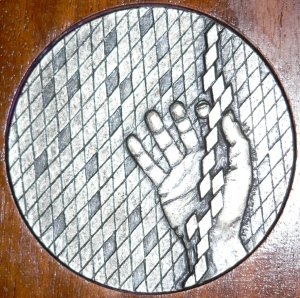
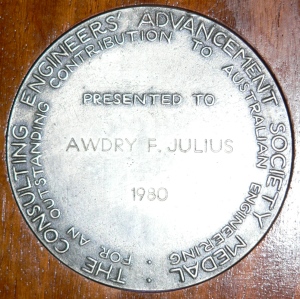
This is one of several pages relating to the history of the automatic totalisator, its invention in 1913, the inventor George Julius and the Australian company, Automatic Totalisators Limited that he founded in 1917, which became a monopoly (later part of an oligopoly) in this field. This page provides information on Sir George Julius and may be of interest to those chasing Julius genealogy. This is a history only non-commercial page. If you wish to start from the beginning then go to the index .
| Sir George Julius |
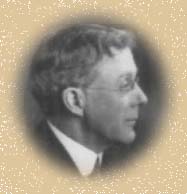
George Julius was the founder of Julius Poole & Gibson Pty Ltd and Automatic Totalisators Ltd, and during his life he gained a wide reputation as a Consulting Engineer. He invented the world's first automatic totalisator. He was the first Chairman of Australia's Council for Scientific and Industrial Research, now the world-famous Australian Commonwealth Scientific and Industrial Research Organisation (C.S.I.R.O.). In 1929 he was knighted for his contribution to technology.

From an early age, George's mechanical inclination was obvious to his parents. He had an inquiring mind and skillful fingers and loved helping his father fix clocks in the small workshop at the back of the manse.
George Julius attributed his mechanical inclination to two generations of ancestors. As reported in the Melbourne Herald (22 August 1931):
"Any inventive capacity I may have may be attributed to inheritance through two generations. My father inherited his love for mechanisms from his father, who was one of the Court physicians in London, but had such a mechanical bent that he spent what money he had in backing any invention that had wheels on it."
George Julius entered Melbourne Church of England Grammar School in 1885. After matriculating, he followed his family to New Zealand where his father had been appointed Bishop of Christchurch. Here the Bishop demonstrated his continued interest in mechanisms by going up in a bosun's chair accompanied by the local Rabbi, to lay the finial on the rebuilt cathedral spire which had been shaken down by the earthquake of 1890.
In 1890, George Julius enrolled in a BSc( Mechanical Engineering) degree course at Canterbury College, University of New Zealand. Because of the contemporary boom in railway construction, he specialised in railway engineering and was the first such engineering student to graduate from this university.
| Professional Career |
In 1898, he married Eva O'Connor, daughter of C.Y. O'Connor, a celebrated engineer from Western Australia. They had three sons; the eldest Awdry Francis (born 1900) was later to become a partner in his father's firm.
While working for the Government Railways, George Julius conducted a series of tests on timber and wrote a handbook entitled Physical Characteristics of the Hardwoods of Western Australia published in 1906. He followed this with the publication of Physical Characteristics of the Hardwoods of Australia, published in 1907.
His research on hardwoods attracted a good deal of attention and led to a job offer from Allen Taylor & Co Ltd, a timber company in Sydney, as part-time engineer at an annual salary of 550 with the right to private practice. Accepting this offer in 1907 George Julius moved to Sydney, settling his family into a new home in Ocean Street Woollahra.
The following year he set up a consulting office in the Equitable Building in George Street. His practice, the first of its type in the country was immediately successful.
| Automatic Totalisators |
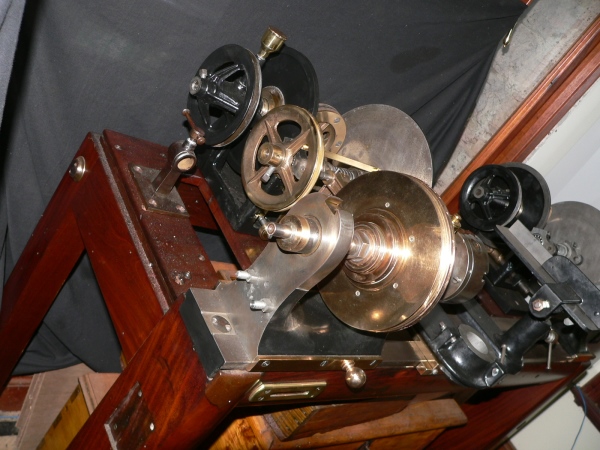
I have added the above image which is not part of the original document. The above lathe belonged to George Julius. He used it to produce much of his early tote work including the prototype mentioned above. It now belongs to George's great grandson Tony Shellshear. Tony is engaged in a rigorous project to return this lathe to its original condition. It has already undergone a major transformation to be in the condition shown in this photograph. The lathe was manufactured by Evans and Sons of London in 1830.
However, the automatic totalisator was not originally conceived as a betting machine, but as a mechanical vote-counting machine. Julius reported:
"A friend in the west conceived the idea of getting me to make a machine to register votes, and so to expedite elections by giving the result without any human intervention. I invented one that aroused some interest, and it was submitted to the Commonwealth Government."
When the Government rejected the voting machine George Julius adapted it as a racecourse totalisator.
"Up to that time I had never seen a racecourse. A friend who knew of a "jam tin tote" - a machine which kept a sort of record of tickets sold at each window - explained to me what was required in an efficient totalisator. I found the problem of great interest as the perfect tote must have a mechanism capable of adding the records from a number of operators all of whom might issue a ticket on the same horse at the same instant."
"I set to work on a machine that would permit the simultaneous addition, give instantaneous records, and would satisfy the requirements of any racecourse."
"The model was built in my spare time, and when perfected a company was formed and secured its first order for a machine at the Auckland( Ellerslie ) Racecourse in 1913."
Webmaster's Note:
The company that was formed that George refers to was Totalling Mechanisms Limited, which later morphed into Automatic Totalisators Limited. To read details about it go to Automatic Totalisators Limited - later ATLDuring the Great Depression continuing design work on the tote kept Julius Pool & Gibson in the black when many professional firms were going under. Awdry Julius has commented:
The original mechanical totes were large, each one filling a machine room 10 X 10 metres. Awdry gradually took over all design work from his father and was responsible for research and development. He was elected chairman of the Automatic Totalisators Board in 1950 and was a member of the board until 1975 when the company was taken over by Smorgons Consolidated Industries, a Melbourne company.
Webmaster's Note:
I have added the following images here as Awdry Julius is mentioned above. These images are provided courtesy of Tony Shellshear Awdry's grandson. Awdry was presented with this medal from The Consulting Engineers Advancement Society for an outstanding contribution to Australian Engineering in 1980.
Awdry Julius' Consutling Engineers Advancement Society Medal

"Julius" Automatic Totalisators were operated until recently with the last one going out of service on 25 September 1987, at Harringay Stadium, a dog-racing track in North London.
Webmaster's Note:
In 2005, long after the above sentence was written I received an email from an engineer in Caracas. I was informed that the Julius tote there was still in operation. After 48 years of operation I was asked if I have any information on how to make adjustments to the system to bring it up-to-date!
| Council for Scientific and Industrial Research |
In its early years before acquiring its own offices, the CSIR (CSIRO) met in a room at the back of Julius Poole & Gibson's office in Culwulla Chambers. (See image of Culwulla Chambers below)
As chairman of the Council related to primary production, it was therefore decided to concentrate on five main groups of problems. These were:
In the thirties Sir George Julius realised there was a need for more research work in secondary industry. Despite strong opposition from the Department of Defence to any extension of the activities of the CSIR, he presided over the establishment of a Division of Aeronautics and was appointed chairman of the important Commonwealth Committee on Secondary Industries Testing and Research in 1936. According to CSIR Chief David Rivett:
"The switch of the CSIR to secondary industry and into many aspects of defence planning probably stemmed from a visit by BHP chief Essington Lewis to Japan in 1936. He returned thoroughly alarmed at what he saw and urged the Lyons Ministry to act immediately to produce planes and fliers."
George Julius concurred. By 1938 he had convinced the Government that 143000 pounds would be needed for Aeronautical Research Laboratories to be built at Fishermans Bend near Melbourne. The Daily Telegraph, 7 April, 1945 recorded:
"Generally it is he ( Julius ) who has to battle for new funds, and getting money in lump sums is no sinecure."
"Sir George's value to the Council was in contact with politicians. He was flexible and extremely shrewd in his handling of the species Homo Politicus."
"Without his experience, ability to manoeuvre and thorough understanding of when to concede in appearance without surrendering the substance, the independent scientists might not have had so smooth a run through CSIR's first twenty years."
| An Anecdote from Jim Loveday |
Webmaster's Note and additional image:
I have often wondered what working with George might have been like. The answer to this question is well beyond the scope of this text however I found the following extract from the book From Tote To CAD a somewhat comical glimpse. Geoffrey Charles (Jim) Loveday was a partner of Julius Poole & Gibson from 1951 to 1974. By 1913 Julius Poole & Gibson had to move, this time to Culwulla Chambers in Castlereagh Street, Sydney where the office remained until 1971. It was fortuitous that George Julius had been commissioned to supervise the design and installation of the high-speed lifts in this office building designed by architects Spain Cosh & Minnett, which was Sydney's first skyscraper.
Culwulla Chambers July 2008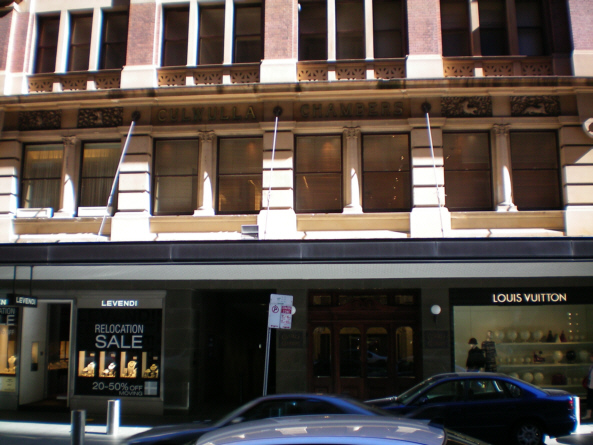
Culwulla Chambers was the home of Julius Poole & Gibson from 1913 to 1971 and the birthplace of the CSIRO.
Back to the book From Tote to CAD:
Jim Loveday had a cheery and affable personality. He loved to tell a story of the early days when he was working under the usually strict and demanding eye of George Julius. The following anecdote took place at Culwulla Chambers.
Sir George had a buzzer installed which he used to summon us to show the progress of our work. One day the drawing I had just finished blew out of the window and floated down Castlereagh Street where it was run over by a tram. I rushed down stairs, retrieved the remains of the drawing and got back just in time to hear the buzzer sound twice which was the signal for me to present my work.
Sir George slowly eyed the mutilated drawing in my hands and simply remarked dead pan "You've made quite a mess of this drawing, Loveday, I expect to see some improvement in future".
On the subject of Culwulla Chambers, it was built to a height of 53.5 metres and featuring an intricate sandstone facade, it was a controversial building from the first.
Protests to the Sydney Municipal Council about the shadow the building cast and the inability of the fire-fighters to reach a fire in the upper storeys caused the hasty introduction of a building height limit of 45.7 metres throughout NSW.
This height limit restricted development of taller buildings until the early 1960s and so Culwulla Chambers remained the tallest building in Sydney for 50 years.
Culwulla Chambers was the home of Julius Poole & Gibson from 1913 to 1971, when extensive renovations forced the firm to vacate and move to offices in St Leonards.
Webmaster's Note:
It is ironic that I chose this extract regarding Jim Loveday. Frank Matthews, the last senior partner of Julius Pool & Gibson, and I discovered many years ago that we practically lived on the same street in Gordon. He lived on Lennox St. which ran into Waugoola St. where I lived. I practically drove past the house where he grew up every day for over a decade. In June 2017 Frank sent me an email informing me that Jim Loveday owned a house in Lennox St. Following is an extract from Frank's email:As you know I lived in number eight Lennox Street Gordon and around that time Jim Loveday bought a house in Lennox Street, the first one from the corner of Rosedale Road, it probably would've been number 2. I knew it well, it was always vacant and we kids used to play in there, it had a great passionfruit vine on the back fence which we would raid. I only found out many years later, after joining JPG, that this house was owned by Jim Loveday, he was living on Sydney harbour just next to the zoo, and bought the house as security after the scare when the Japanese submarines entered the harbour.Jim Loveday was at university together with Awdry Julius, before they both joined JPG.
Back to the book From Tote to CAD:
| The Standards Association of Australia |
George Julius, William Poole and Alexander Gibson were counted amongst the number of a small but far-sighted band of engineers who in 1922 promoted the formation of the Australian Commnnwealth Engineering Standards Association (ACESA), the forerunner of the Standards Association of Australia (SAA).
When appointments to the main committees were gazetted, two representatives from Julius Poole & Gibson had been nominated. George Julius had been elected Vice Chairman and William Poole was appointed to serve on the Concrete Committee.
By 1926 when George Julius succeeded Sir George Knibbs in the Chair, there were over 250 sectional, sub and panel committees, and over 1,500 people voluntarily engaged on the preparation of specifications for standards.
One example of George Julius' imaginative leadership was his effort in 1927 to prompt the Board of Trade to convene an Empire Conference on Standardisation activities in close collaboration. From this initiative the national standards bodies of many countries of the world co-operated to form the International Standards Organisation.
On 1 July, 1929 George Julius presided over the amalgamation of the Australian Commonwealth Engineering Standards Association (ACESA) and the Australian Commonwealth Association of Simplified Practice, becoming Chairman of the new body, the Standards Association of Australia (SAA) now known as Standards Australia.
In 1972 a paper entitled "Fifty Years of Australian Standards", F.M.Matthews, Chairman of Council, Standards Association of Australia acknowledged the efforts of George Julius during the Association's early years:
No person has done more for standards in this country than Sir George Julius. He was appointed Vice Chairman (of ACESA) in 1922, became Chairman in 1926, and continued in that office until his retirement in 1939.
We are very fortunate that the ability and energy of this eminent engineer was available to the Association during the early, formative years. It was largely due to him that the wretched years of the depression were tided over.
| The Institution of Engineers Australia |
By the end of World War 1 both Julius and Poole recognised the weakness of the many small and independent engineering societies each lacking interstate membership and representation, and so became closely involved with the formation of a united, Australia-wide engineering institute. In his Presidential Address in the Electrical Association of NSW in November 1918, Julius made a strong plea for support of the concept of one institution, representative of the engineering profession.
It is clear that to do any good, engineers must organise themselves. They must widen their outlook interest themselves in national and civic questions, study economics, and educate themselves and the public to better realisation of the beneficent effects of sound engineering practice.
Then, and only then, will they be able to speak with one voice and with authority, demanding and receiving that consideration for their opinion and advice that it undoubtedly deserves.
In time even we may be able to persuade the politicians that the advice of engineers may sometimes be useful, and that they ought to fill an important role in the development of such a country as Australia, if efficient results are to be obtained.
A conference of interstate delegates was held in Melbourne on 12-13 February, 1918 to select a provisional council to preside over the formation of The Institution of Engineers, Australia. This was followed by a meeting in Sydney in May, 1918, when Mr D.F.J. Harricks of the Engineering Association of NSW was elected chairman and the outline of a draft constitution tabled.
By 1 August, 1919 twelve independent societies throughout Australia had decided to amalgamate with the Institution. The problem of membership was resolved by agreeing that all persons on the membership rolls of associated societies were entitled to enrolment in the new institution.
George Julius was elected to this first Council and became President in 1925.
The Council of the Institution of Engineers Australia
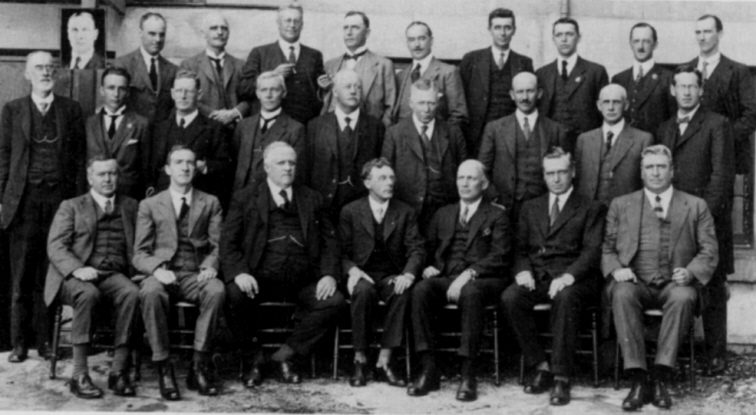
The above photo is the Council of the Institution of Engineers Australia at its meeting in Hobart in 1926. G.A. Julius President - front row centre, W.Poole Councillor - second row centre, A.J. Gibson Councillor - back row fourth from right.
The image below is a colourised version of the image above enhanced by Don McKenzie a long serving Automatic Totalisators Limited engineer in Melbourne who has a website on the Victorian branch of Automatic Totalisators Limited. I have left the original image of the photo above as that is its original form, to preserve the history this website is presenting.
Don McKenzie's Colourised version

| Central Inventions Board |
Sir George Julius remained active as a committee representative until his death.
| Honours and Other Activities |
George Julius received many honours, including the highest award of the Institution of Engineers, Australia, the Peter Nichol Russell Medal in 1927. He was knighted in 1929, primarily for his work with the CSIR and received the W.C. Kernot Medal from the University of Melbourne in 1939.
Webmaster's Note: I have added the following images associated with the above text, to this document courtesy of Tony Shellshear, George's great grandson.
George Julius' Peter Nichol Russell Medal
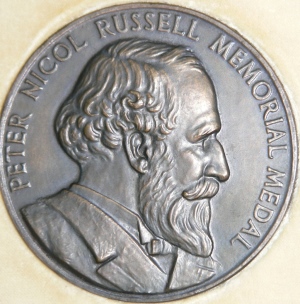
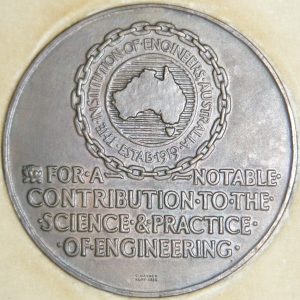
George Julius' Knighthood Medallion
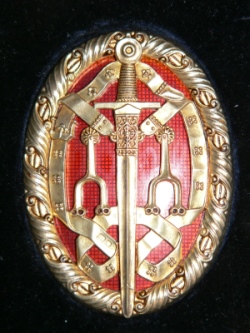
George Julius' Kernot Medal
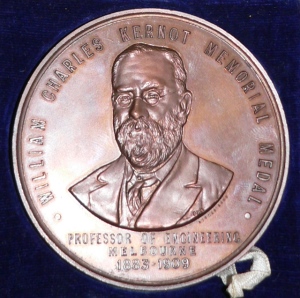
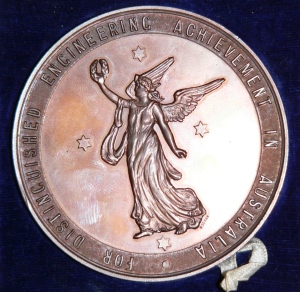
In 1940 he was awarded a DSc by the University of New Zealand.
Sir George Julius retired in 1945 and died on 28 June 1946.
The Sir George Julius Medal
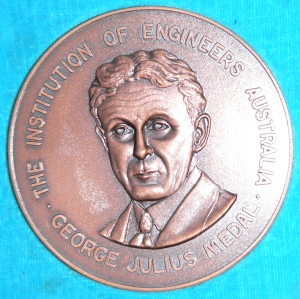
The Institution of Engineers Australia remembers George Julius, with the Sir George Julius Medal, awarded for the best publication in the field of mechanical engineering.
| Sir George Julius Eulogy |
Following are extracts from Sir George's eulogy which give further insight into George's personality to that provided in Jim Loveday's earlier comical anecdote. These extracts come from Edward Fenn's very impressive website, The King's Candlesticks at http://www.thekingscandlesticks.com/
Not of the type which commands the glare of the spotlight or the glitter of popular recognition, his record is rather one which, to the more discerning of the present and future generations, will mark him as one of the great nation builders of this young country. If the destiny of Australia is to be shaped by the sound development, on modern scientific lines, of her primary and secondary industries, the work of Sir George Julius will have contributed in very large measure to the moulding process...
Out of Sir George's fertile brain and his delight in the solution of mechanical problems, there was born the totalisator. That it proved to be a valuable and useful adjunct to the Sport of Kings is merely incidental, though in the minds of many of the public it is Sir George's best known achievement. It is indeed an achievement, for it is a masterpiece as a " congruous concourse" of simple elements and fundamental principles into a perfect specimen of mechanism for smooth and accurate performance of a complex operation. That it was an aid to the making and winning, or losing, of bets on the relative speeds of horses was never a matter of any great interest to the designer...
A recital of the professional and scientific achievements of this great engineer, surpassing as the achievements have been, is to tell but the lesser part of the story of his life. To those who loved and revered him it is the personal qualities of the man, George Alfred Julius, which will be ever remembered. He was a man who impressed one on first acquaintance as one who counted in the scheme of things. He could, too, be most cordially friendly in a encounter with one with whom he felt any bond of sympathy, and would indulge in pleasant raillery that immediately put one at ease. Yet he was of too deep a nature to form friendships on sight and it was only as one grew to know him that one fully appreciated all his finer qualities. His soundness of judgement, proved time and again over vast experience, had bred in him a strong conviction of the rightness of his opinions, yet withal he was a man of great humility of spirit: a seeming contradiction to which only long acquaintance gave an understanding. He was capable of strong and loyal friendships, in which he delighted. He was generous in victory but could take defeat in the best grace. Though both came to a man who always fought hard for the cause he was interested in, victories were more common because through intrinsically sound judgement, effectiveness in negotiation, and persistence in effort, he usually won the day for his side...
His faults were the faults of greatness, the kind that those who knew him well smiled over and rather liked him for. His conviction of the soundness of his views made him a difficult opponent to deal with in debate. His hatred of all meannesses of the spirit made him intolerant of pettiness, small mindedness, and mental weakness. He could not dissemble, when disgust at evidences of such attributes swayed him. To his fellow-members of the Council of the Standards Association of Australia, and particularly to those of them who were privileged to have had long and close association with him, Sir George Julius will ever be remembered as a notable engineer and scientist, a successful leader and administrator, a truly great Australian citizen, and a generous-hearted and lovable man.
 Go back to the index
Go back to the index
 Go to the bottom of the page
Go to the bottom of the page
| Julius Avenue |
On the 10th January 2004 I received an email from Kevin Shaw. Following is an extract -
I am active in the Ryde District Historical Society and, of course, we have the old ATL factory in our district. It is on the Ryde heritage list and when we do bus tours, we take people to see it. I was also an employee of CSIRO for 31 years without ever knowing that there was a connection between George Julius and Meadowbank. Do you know there is now a Julius Avenue at Riverside Corporate Park, the CSIRO development at North Ryde? Kevin confirmed that Julius Avenue was named after George.
There is another Julius memorial street name. It is Julius Road in Canberra on Black Mountain.
It is now March 2017. Last December, Bob Plemel, the ex ATL Engineering Manager and I visited the ex ATL factory site at Meadowbank, whilst we were in Sydney for the ATL annual reunion dinner. We knew the building had been demolished and when we looked at the site it was just a hole in the ground. Similarly the ex ATL Toolroom building site across the road was also part of a bigger hole in the ground. We knew our old workplace had been demolished and we found it to be a hole in the ground. We reminisced about our beginnings in this old workplace. Bob asked one of the construction men what they had done with our factory. He replied by asking about the company that occupied the factory. After our short rendition of the history of Automatic Totalisators Limited, he finally suggested we might like to purchase some units. Bob and I did visit a sales office in the area out of curiosity.
Kevin Shaw who wrote above about the Meadowbank ATL factory, wrote again about the demolition of the factory:
I am sorry about the destruction of the Meadowbank building, and also because I did not forewarn you. The Art Deco frontage survived briefly when the rear was removed about 15 years ago but then the juggernaut of apartment developers arrived, and even though the ATL building was on Ryde's heritage inventory, it was only considered of local significance and was not spared. I am afraid I have lost hope about heritage in Ryde and I did not stand in front of the bulldozers.Additionally, whilst in Sydney in 2017 as mentioned above, Narelle and I visited George Julius Ave in Zetland. I was only informed of its existence in recent years. It is on the site of what was Victoria Park Racecourse which was later occupied by the large Morris Factory that operated for many years. A similar process to what is happening at Meadowbank had already taken place in Zetland, as I remember this area of Sydney as being industrial and now it is high density residential. You can read about Victoria Park Racecourse, the Morris factory and George Julius Avenue in the George Julius Genealogy and latterday interest chapter of this website by selecting the Go to the index button in the Navigation Bar at the bottom of this page, then selecting the chapter mentioned and scrolling down to the heading Victoria Park Racecourse.However, I am pleased that the Chalmers St building has survived as it may represent the golden age of ATL. I am reminded of C Northcote Parkinson's adage that you can write off a company when it moves into its new building. Mind you, I am not sure I believe that adage and the pictures from Meadowbank portray a model of efficiency, don't they? Thank you for keeping me in the loop.
| C.Y. O'Connor |
It would be remiss of me to omit making a reference to C.Y. O'Connor mentioned above. Charles Yelverton O'Connor was another of Australia's great engineers and George Julius' father in law. He was Western Australia's Department of Public Works Chief Engineer. He had to design and control construction of early infrastructure such as roads ports railways and water supply and was involved in the construction of the Trans Australian Railway. His most famous achievement is the design and construction of the Perth to Kalgoorlie water pipeline a large scale water scheme. This project to provide water to the desert outback goldfields traversing 550 kilometers started in 1898 and was the biggest water main constructed in the world. Critics thought this was an impossible feat. I have a link in the links page of this website to The Golden Pipeline A National Trust Project.
Postscript 1: In March 2011 my wife Narelle and I visited our elder son Paul in Perth. He knew of C.Y. O'Connor as his memory is well preserved there. He also knew of the Golden Pipeline and had visited Mundaring Weir, where the pipeline begins, many times. I could not resist a visit to see it for myself. We had lunch at the Mundaring Weir Hotel, where I later learnt C.Y. O'Connor had often stayed overnight. At the Weir we walked beneath it and on top of it and visited the No. 1 Pump Station which is now a museum. Inside this museum building are the boilers, economizer and one of the 3 steam driven pumping engines. The engines were Worthington duplex triple expansion engines. Each side of the engine worked 180 degrees out of phase with the other side so that when one side had its pump shaft at the end of the delivery stroke to a common non return valve, the other side was at the end of the pump induction stroke about to start its delivery stroke to the common non return valve.
C.Y.O'Connor Statue Fremantle

Postrscript 2: In December 2012/January 2013 Narelle and I visited Paul again. We came across more O'Connor memorials. The above photograph is of the statue of C.Y.O'Connor outside the Fremantle Port Authority building. The design of Fremantle Harbour is another of C.Y.O'Connor's crowning achievements. Expert opinion at the time, 1892 held that establishing a harbour at the Swan River estuary would be problematic requiring constant dredging. Queen Victoria decorated C.Y.O'Connor for his achievement establishing Fremantle Harbour, and time has proven O'Connor's design sound. We also visited C.Y.O'Connor beach and photographed his statue there. From this beach you can see Fremantle Harbour. We also noted the existence of the O'Connor electorate and suburb of the same name and a street named O Connor Cl. During our stay in Western Australia we drove to Albany via Narrogin. In Narrogin we saw signposts which led us to buildings bearing the name "C.Y.O'Connor Institute", "Education | Training", "Narrogin Campus". We also came across similar signs to a C.Y.O'Connor Institute Campus during our drive to Geraldton.
| Julius Poole & Gibson The Original Partners |
Back to the book From Tote to CAD:
Late in 1907 a young engineer moved his family from Perth to Sydney intent on starting a consulting practice in mechanical, electrical and civil engineering. He chose Sydney for his headquarters after receiving an offer of part-time employment there with the timber merchants Allen Taylor & Co, a firm he had come to know through his previous employment with the Western Australian Government Railways.
The business started by George Julius early in 1908 prospered and soon included a client list naming some of the best known businesses and government instrumentalities in NSW. George Julius at the same time became deeply involved in developing his automatic totalisator invention and being a true professional, joined the Engineering Association of NSW becoming its president in 1911.
William Poole, five years older than Julius, was from 1904 to 1912 Director of the State School of Mines at Charters Towers in Queensland. It was unlikely that Poole and Julius were then well acquainted, possibly only in passing or by reputation. Poole, however, was respected among the professional staff at Sydney University Engineering School, where he had graduated in 1900. He was an active member of the Sydney University Engineering Society and had joined the Engineering Association of NSW.
Through these activities Poole became acquainted with Alexander Gibson, a young civil engineer and naval architect, who in 1903 had been appointed lecturer in building engineering design at Sydney University and who was a member of the Engineering Association of NSW.
In 1908, when Poole was at Charters Towers, Julius and Gibson began to collaborate closely in the activities of the Engineering Association and came to have a great and lasting respect for each other.
After 1910, when Gibson was appointed Foundation Professor of Engineering at the University of Queensland, moving to Brisbane, he maintained his contact with both Julius and the Association and shared common interests with Poole as another prominent engineering educator in Queensland.
by 1912 Poole could foresee the end of the mining boom at Charters Towers. He decided to move south again, partly because the torrid environment was affecting the health of one of his children. It is not surprising then, that he turned to Gibson for references to support his applications for a number of academic positions.
He was successful in receiving an appointment as Principal and Head of the Engineering Department of the Ballarat School of Mines so he and his family moved to Ballarat in Victoria. Although he set about his new duties with enthusiasm, he was never happy in this position and unsuccessfully applied for a number of other academic appointments within the next year.
At that time Julius' practice was expanding and included a considerable volume of work of a civil engineering nature. Julius was clearly in need of an experienced engineer to help run his business and a man of Poole's reputation and connections seemed to be just the answer. Gibson was then still at the Univeristy of Queensland and although no direct evidence is available might well have acted as a catalyst to Poole's appointment because of his knowledge and admiration of both of these men.
Julius accepted Poole as a partner in May 1914 and the firm's name was changed to Julius & Poole.
Following the outbreak of World War I in 1914 there ensued a quiet period in Julius and Poole's practice except for detailed mechanical and and electrical design work on totalisator projects. It was not until 1922 that the firm rapidly expanded, commencing with a major water supply scheme for Rockhampton, Queensland and therein lies the key to Gibson's entry into the partnership.
In January 1919 Gibson had resigned his chair at the University of Queensland to take up the position of superintendent of construction for Broken Hill Proprietary Company's new steelworks then being constructed in Newcastle, NSW. His impressive reputation as a wide ranging civil and mechanical engineer had followed him from Queensland to Newcastle for , late in 1921, he had been approached by the Municipal Council of Rockhampton to enquire if he would be available to investigate the unsatisfactory water supply for that city. It was thought that Gibson could select the best scheme from several proposed over a period of many years by other engineers and authorities or recommend a suitable alternative.
Gibson advised that he was able to accept the offer of this limited consulting commission. Realising that if the right team were available he could gain a major design contract, Gibson immediately entered into discussion with his respected engineering acquaintances Julius and Poole, suggesting a joint effort through which all the skills and experience were available to handle a large water supply project.
By the end of 1921 Gibson was engaged to report on the Rockhampton water supply scheme as a partner in the firm of Julius Poole & Gibson. Immediately he handed his resignation to BHP to date from the end of January 1922.
Backed by the full support of his new partners, he set to work on a year of study which led to the adoption of his recommendations by the Rockhampton Council on 16 April, 1923 and ultimately to the completion of the scheme under his direction in 1925.
Gibson is officially recognised as joining the partnership of Julius Poole & Gibson in January 1922. The three men remained in effective partnership until Poole's death in 1929. To this day the firm continues to operate under the name Julius Poole & Gibson.
| Julius Poole & Gibson since 1988 |
As this chapter has the most content regarding George's engineering consulting company Julius Poole and Gibson, I thought it appropriate to add this latter-day information regarding this company here, which is kindly provided by company director Max Sherrard. These words were written over a century after George Julius founded this engineering practice. Max Sherrard, in 1974 was a partner responsible for the structural and civil engineering departments, and a Director of Julius Poole & Gibson.
The book "From Tote to CAD" was launched at a small function in early 1989 by Professor Peter Johnston, Chancellor of University of Technology, Sydney. Peter had worked at JPG as an apprentice draftsman prior to serving in RAAF during WWII. He subsequently formed a most successful architectural practice in Sydney.
Julius Poole & Gibson now occupying the two upper floors of 9 Atchison Street, St Leonards were finishing off their share of the Darling Harbour works, and attempting to adjust to the edict of the new NSW government that there was to be no more employment of "consultants" as pseudo employees within their instrumentalities. Unhappily this decision affected quite a few of our staff. In effect the work load dropped off markedly. The directors were also anxious about the future outlook for the firm with them each approaching retirement. Ultimately the bullet was bitten and it was decided that the firm would merge with Bassett and Partners.
Bassetts, though originating in Melbourne in 1934, had a similar culture and reputation to JPG.The merged firm commenced in 1992 as BassettJPG, providing the combined range of services. JPG's staff became Bassett employees and the directors were given 3 year contracts, with JPG ceasing to practice.
In 1995, Julius Poole & Gibson were invited to participate in a significant project for CSR. Consequently a working arrangement was made with Hughes Trueman Ludlow, a civil/structural firm to jointly carry out this work. This enabled JPG to resume practice in its own name as the 3 year period of embargo had elapsed.
Julius, Poole & Gibson continued regular practice until 1995. Since that time the firm has provided service in the structural area to only a few of its longstanding clients. Max Sherrard and his wife are the current directors. Frank Matthews works part-time with an architectural practice, Theo Crowley spends some time assisting his son, Mark, with his mechanical building services consultancy, while Warwick Cooney has migrated to Queensland for the better life.
Thus the firm "Julius, Poole & Gibson Pty Ltd" exists in form only, but not a shadow of its former self!!
Max Sherrard January 2010
| more extracts From Tote to CAD |
I have included some more extracts from the book Julius Poole & Gibson The First Eighty Years -- From Tote To CAD. I have included these extracts from the Foreword and Preface written in 1989, as they eloquently present a precis of the activity and achievements of this company and some vivid images of life within it. Following are some extracts from the Foreword in this book by Professor Peter Johnson AO Chancellor -- University of Technology, Sydney and Director -- McConnel Smith & Johnson Pty Ltd, Architects. Professor Johnson was introduced in the above section titled "Julius, Poole & Gibson since 1988" by Max Sherrard. I have added the colour emphasis which does not exist in the original text.
It is a fascinating experience to review the work of Julius Poole & Gibson as ably set out in this book, from my perspective of a long experience as an architect but having started my professional life in 1941 as a cadet engineer in the firm's office in Culwulla Chambers. Perhaps that gives me the excuse to reminisce about the partners I knew for only a year before leaving for the air force, subsequently forsaking engineering for architecture.
We, the office juniors, then knew Alexander Gibson as "AJ" -- slender and gaunt with a quiet but firm smile and manner -- and with thoughtful advice to the junior members of staff. His rather formidable four square but friendly secretary, Miss Dent, sent the cadets round the corner to Woolworths to buy sandwiches for the staff -- no doubt with AJ's approval, to ensure that they didn't get too big for their boots, developing an appropriate sense of humility early in their professional careers.
Sir George Julius was rather more remote, and in my perception anyway, less involved in the day to day activities of the office. I don't recall ever penetrating into his room. Out the back, however, beyond the normal office, there was a room with a glazed door with the gold, black-edged letters CSIR, the home of the mysterious Council for Scientific and Industrial Research, of which Sir George was Chairman. He and his elegant scholarly secretary occasionally traversed the drawing office on their way to this room, appearing to be deep in thought as they went.
I recall more vividly Joe Fry, who seemed to explode through the entrance door in the mornings on the way to his office, always with a sense of great purpose and inevitably, his coat streaming behind him as he strode along. Although he had a considerable impact on the office he wasn't then a partner -- a status he attained in 1944 after 18 years' service. In those days spurs really had to be earned!
By contrast, Awdry Julius was much quieter, reserved, usually smoking a pipe, emerging from his office at the far end of the room to come and stand in front of an intricate drawing of mechanical equipment, with all the assurance of an eastern sage. His communications to the draftsmen were conducted quietly and economically before he once again withdrew to his room. he also became a partner in 1944, but after 19 years' service! I can't remember Awdry Julius and Joe Fry in conversation together. They seemed to be on separate paths which rarely, if ever, crossed -- ships passing in the night.
There was about the office a sense of dignity and quiet purpose with voices rarely raised. It had that slightly musty but reassuring smell, developed in places where books and files and drawings have been stacked and stored in still places for many years, overlaid with wax polish and lino floors -- in contrast to today's world of rapid change, of computers and carpets and air conditioned uniformity.
There was elsewhere in the building another smaller office where Jock Tolerton presided over structural calculations and structural drawings, a place which always seemed by contrast more boisterous, more in touch with the outside world. No doubt his office was contributing to the development of the firm into its next phase.
That experience of one year was a very small taste of the work of an office which has been engaged in an extraordinary range of projects from 1908, when started by George Alfred Julius, to the present day, responding to the varying needs of the community over this time. The firm has made contributions of the highest order not only in the provision of professional services but also to scholarship in engineering, to research and to the general public good in many ways.
There are, in this account, many remarkable stories of the people who have built the firm and of the inventions, projects, universities, organisations, committees, connections, causes and ideals with which they were involved. A constant theme has been the belief in the profession of engineering, in professional values and in the need for the various professions of the building and construction industry to work closely together -- of more importance today than ever.
In August 2018, whilst walking down Harris Street in Sydney, I noticed one of the UTS (University of Technology Sydney) buildings on the northern side of the street, which had a first floor level entrance via a walkway across Harris street, which has the name "Peter Johnson Building" above the entrance. I recognised the name as Professor Peter Johnson the person who wrote the foreword for "From Tote To CAD."
Following are some extracts from the Preface to the book "From Tote to CAD." This Preface was written by Frank Matthews, Chairman of Directors, Julius Poole & Gibson Pty Ltd. Frank was the last senior partner of the firm. Frank Matthews was introduced in the above section titled "Julius, Poole & Gibson since 1988" by Max Sherrard.
This book was written because memories grow dim and records tend to disappear. As Julius Poole & Gibson is the longest established Australian consulting engineering practice there seemed to be a duty to produce a historical record before it was too late.
Awdry Julius, son of the founder of the firm, Sir George Julius, made a start prior to his retirement in 1975. Geoffrey Charles (Jim) Loveday, also one of the second generation partners, compiled a certain amount of useful information before his death in 1975 but the enormity of the task was too ready an excuse for procrastination.
It was not until 1987 when Max Anderson's good nature was prevailed upon to research the early years of the firm's history that this project began to take shape to conincide with Australia's Bicentenary and the firm's eightieth birthday.
How George Julius, William Poole and Alexander Gibson, all such prominent but diverse personages, came into partnership began to intrigue Max.
George Julius was the ultimate colonial professional, well educated and connected, a brilliant engineer and innovator, a public figure and confidant of Prime Ministers.
Within the firm little was known of William Poole except that he had qualified and established himself as a professional engineer and at the time George Julius had started his practice was head of the Charters Towers School of Mines in Queensland.
Alexander Gibson, amazingly, had no early formal professional qualifications but had an innate engineering talent and enormous penchant for self-education. This quickly took him from an apprenticeship in a Scottish shipyard to the foundation chair of Engineering at Queensland University, at the early age of 34.
Why had these men joined forces? The discovery of personal papers and effects kept by Miss Jean Poole, William Poole's only surviving child now living in Elizabeth Bay, New South Wales, supplied some answers. These together with research done during a visit to Rockhampton helped Max to reconstruct the events leading to the formation of the long-running partnership.
Of the current directors, I now remain the sole link to any of the three founding partners. When I joined Julius Poole & Gibson as a young engineer in 1955, Sir George Julius and William Poole had of course long gone, but Professor Gibson was still a consultant to the firm and coming in to the office two or three days a week.
On my first day he called me in and introduced himself as the old and "extinguished" member of the firm. Obviously he was not altogether "extinguished" despite his 79 years because he had just married his secretary of 25 years, Miss Ann Dent.
At the time George Julius founded the firm in 1908 his mind was working on an idea for an "automatic totalisator", an invention which some five years later he patented. He established the company Automatic Totalisators Ltd, to design and manufacture his invention, which occupied much of his energies and that of his son Awdry over the next 50 years.
The tote, as it became known, was a mechanical machine which counted wagered money and added, divided and integrated to provide a continual computation of racecourse odds. As such it was the forerunner of today's computer which does in principle much more compactly and quickly what was done by the giant mechanical Tote.
In today's world the ubiquitous computer plays an important part in almost every business. To the consulting engineer the computer has been an important tool for more than a decade and more recently, computer aided drafting and design (CAD) has become a must for the progressive practice.
To epitomise in some way the history of Julius Poole & Gibson's 80 years in practice it seemed appropriate to use the title "From Tote to CAD".
There are so many interesting projects in "From Tote to CAD" it is difficult to select one to include some extracts here. I have chosen the Sydney Opera House as I have an association with this project. I worked on the Sydney Opera House installation and commissioning, not for JP&G but AWA (Amalgamated Wireless Australasia), a sub contractor to JP&G. AWA provided the CCTV and Audio systems for the Opera House. The chapter from which this extract originates is titled "The Sydney Opera House - 1963". Note: Utzon refers to the architect Jorn Utzon.
In the meantime Ove Arup, the structural engineers, had engaged a local firm, Macdonald Wagner & Priddle, to carry out on-site supervision of the structural work. According to Frank Matthews:
"When Utzon came to Australia, he asked Macdonald Wagner & Priddle if they could also carry out the electrical supervision. They said 'no', but they had some good friends - Julius Poole & Gibson -- who certainly could. There was a phone call to us and we had the job."
Julius Poole & Gibson were appointed secondary consultants on 1 July 1963. Frank Matthews had just become an associate after nine years of service with the firm, and was put in charge of the job.
"We were engaged by Utzon to examine the documentation prepared by Zeuthen & Sorensen, to make sure that it was written in a form that local contractors could understand, to check drawings for compliance with local regulations and ensure that proper use of Australian materials was made and then to supervise the installation work."
For the first four months Frank Matthews worked with the Danish engineer Henning Jensen, from Zeuthen & Sorensen, going through his drawings, getting to know the requirements for the vast and intricate system of electrical and electronic services.
In addition to the general electrical services, the job included electro-acoustic systems designed to provide sound amplification and distribution for the performing and public areas, signal and intercom systems for communication to performers and stage technical staff, closed-circuit television, simultaneous interpretation for congress, radio paging, PABX telephones, night watchmen patrol systems and many other electrical and electronic aids necessary for the production of the varied types of activities to be staged within the different performing areas.
For the next year, Julius Poole & Gibson refined the documentation and amended it to suit the developing architectural detail. An office was established in the prefabricated shed near the Man O'War Steps.
"Utzon was tremendously enthusiastic and a most inspiring person to work for. He was marvellous at getting people motivated."
"He gave us a thorough indoctrination early in the piece impressing upon us the high standards of design and quality of work he wanted. Finding a better way of doing something was considered part of the brief."
"The worst thing you could say to Utzon was : 'That's not how its done in Australia', or 'Doing what you suggest is going to be difficult or expensive'."
"His reply invariably was: 'We are here to nudge the frontiers of science. This is an opportunity to improve the latest technology, to develop new ideas and to test new methods and materials.'"
"On several occasions when working late at night, Utzon would come into the office and say to me: 'Frank, come with me, I want to walk around the site.'"
"As we picked our way through the spaces beneath the empty concrete shells he would wave his arms with great enthusiasm.
'I want you to imagine the sort of lighting I want. The movement of people is to be accentuated by their passing through lighting of varying intensity.'
'I want the Patrons to be able to see the harbour at night. If there is a ferry passing by, I want them to see it, so lighting in the lounges and foyers is to be arranged in a way that night views will be seen clearly without internal reflections'."
So ends the more extracts From Tote to CAD. Following is some more information on the Opera House project as well as some general observations about the subject of totalisator history as it relates to Julius Poole and Gibson.
I very well remember the prefabricated sheds near the Man O'War Steps. We had our site base in similar sheds on the Circular Quay side of the Opera House.
An AWA Audio Console in the Opera House
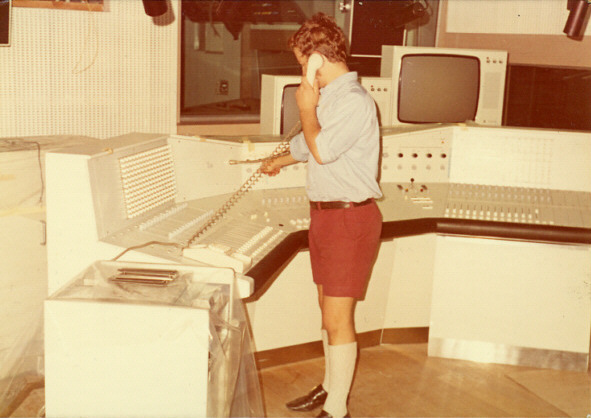
From memory this photograph was taken in the Record and Rehearsal studio. There were multiple control rooms in the Opera House. Others I worked on were in the Concert Hall and Opera Theatre.
In July 2014, I wrote an email to Frank Matthews in which I mentioned the Project manager for AWA, Wes Moon who was our on site manager, who I enjoyed working for. I included in the email that I still had a copy of Electronics Australia magazine January 1974, which has Wes on the front cover sitting at the Concert Hall AWA audio desk which is like the one in the image above! This email struck an accord with Frank and he wrote the following reminiscences regarding AWA at the Opera House:
Your mention of Wesley Moon brings back a lot of memories. JP&G were engaged among other commissions at the opera house as consulting engineers for the design and supervision of the electroacoustics. Wes Moon was the project manager for AWA and was my point of contact. I also recall John Northeast and Ernie Benson who had done a lot of research on the loudspeaker design prior to finalization the concert hall sound reinforcement system. You may be interested in some of the history leading up to the awarding of the contract to AWA. In 1969 I undertook a study tour of opera houses in America and Europe together with Dr. Jordan the consulting acoustician, looking at the latest design in major Concert Hall and Opera Theatre electroacoustics. Dr. Jordan favored a loudspeaker design incorporating 'acoustic tapering' of column speakers whereas AWA at that time were pioneering an alternative 'electronic tapering' system. Because of the work that AWA had provided to us gratis, they put pressure on the government to be awarded the contract without competitive tendering. In the end however it was put out to competitive tender. But AWA won the contract anyhow and their system of electronic tapering (christened has the Luna column) was used in the concert hallSome years later, probably in the early 1980s AWA were designing and building an electronic scoreboard for the Hong Kong Jockey club. Wes had gone to live in Hong Kong to supervise this work but they were experiencing some my problems with the 'heavy' electrics - AWA were expert in dealing with milliamps but not so good when it came to large power amps. I recall that Phil Chapman was AWA's design Boffin and he engaged us look at the problem which basically was the intermittent tripping of circuit breakers due to inrush switching transients. The problem I recall was solved by the simple expedient of series staggering relay contactors.
Anyhow I went to Hong Kong during the final stages of the project and met up again with Wes, who was a marvelous host, taking me around Hong Kong to his favorite haunts.
Frank mentions John Northeast who I remember very well. John was a Technical Officer on the project who I enjoyed working with very much. I recall AWA had particularly pursued the acquisition of this project as it was regarded as prestige.
I find it uncanny how this history always seems to have connections to every avenue of interest that is pursued. In 2009 I gave a lecture to Professor Norman Heckenberg and some of his colleagues from the University of Queensland about the Julius Tote at the Eagle Farm Racing Museum. I discovered prior to this lecture that they had something in common with this history. Alexander Gibson from Julius Poole & Gibson mentioned above joined Queensland University, now known as the Uiniversity of Queensland as their foundation professor of Engineering in 1910. I informed them of this coincidence during the lecture!
Another example is an event that took place in February 2010 when I donated an electromechanical shaft adder from a Julius tote to Another example: David Griffiths, Chair, Academic Senate and Foundation Professor of Statistics, University of Wollongong contacted me in relation to this website in April 2003. An extract from the book From Tote to CAD reveals a connection with Wollongong University and reads:
In addition to the planning of site services which is a continuing commission with the University of Wollongong, Julius Poole & Gibson has been responsible for the mechanical, electrical and structural engineering services for some 20 building projects.
A final example. In January 1999 I received an email from the National Library of Australia informing me that this website was selected for inclusion in their PANDORA (Preserving and Accessing Networked DOcumentary Resources of Australia) project. An extract from the book From Tote to CAD reads:
Several proposals were put before the Committee:-
"A three-story replica of the Secretariat building which would be 'harmonized in its architectural design with other buildings in the government group' and which would accommodate the library as well as provide additional office accommodation at an estimated cost £58,000."
"A monumental building with a 'greatness of structure' characteristic of Capital Cities all over the world."
Julius Poole & Gibson was appointed mechanical and electrical engineers on the project.
Frank Matthews was the last senior partner of Julius Poole and Gibson. Following is an extract from the book "Julius Poole & Gibson The First Eighty Years" relating to Frank Matthews. There are several key members of staff at Julius Poole and Gibson covered in the book. I have selected Frank as I have met him. My wife and I enjoyed reminiscing with Frank Matthews and his wife about JP&G history, Automatic Totalisators Limited history and Sir George Julius, whilst enjoying a wonderful lunch that they provided in March 1998. I worked for AWA at the Sydney Opera House during its construction as indicated above. As previously mentioned AWA was a sub contractor to JP&G and Frank was in charge of JP&G at the Opera House so Frank was our commander in chief so to speak. I had no interaction with Frank at the Opera House however, as he was at the pinnacle of the hierarchy structure and I was at the base. Frank kindly provided permission to use extracts from the JP&G book on the Internet and has provided most of the images in the photo gallery pages of this website. Frank has also kindly donated many of these photographs to me to keep. Copies of some of them are attached to the Julius Tote in the Eagle Farm Racing Museum. In June 2015 I attended a meeting of the Institution of Engineers Australia in that museum, providing information on the Julius tote and answering questions. I was gratified to see that Frank's copied photographs, that I placed on the Julius tote frame years ago, attracted considerable attention.
Frank McClelland Matthews was born on 4 May 1930 in Hornsby, NSW. He entered Artarmon and later Gordon Public School then completed his secondary education at the North Sydney Technical high School, sitting the Leaving Certificate examination in 1947.
From an early age Frank was intrigued by electricity and making things:
"I got my first electrical shock in father's workshop when I was five years old. I made my first electric motor when I was 12. Electricity fascinated me and when I started high school I knew I was going to be an electrical engineer.
Aged 15 when World War II ended while still at school, Frank began building radios in his father's workshop, and selling them, because radios were impossible to get. He made a profit of 100 per cent on each one. Frank Matthews joined the Maritime Services Board (MSB) as a cadet engineer in 1947, and enroled in the Electrical Engineering Diploma course at Sydney Technical College.
"I worked on the design of electrical installations for dockyards, wharves and ports. This involved lighting, and power and communications systems for wharves, cranes, docks, tugs and boats.
"It was an extremely good training for me. In fact, I feel that most of the things I really learnt about engineering, I learnt at the MSB."
Shortly after graduation Frank joined the South Australian Mines Department and was appointed assistant electrical engineer at Australia's first uranium mine, Radium Hill, located 50 miles west of Broken Hill.
"Radium Hill was flat, dusty and remote. I was in charge of the construction, maintenance and operation of all the electrical installations at the mine and at the town site.
"We had our own power station, 45 km of high-voltage transmission lines, pumping stations and various support facilities. There were no resources you could call upon except what was there, and you had to be very innovative to keep things going."
While at Radium Hill Frank studied for the Local Government Engineer's Certificate which would enable him to get a job with a County Council. He sat for the Certificate at Broken Hill in1953, then joined the Ulan County Council, a well-established County Council in NSW which services 2500 sq km of farming country, stretching from the towns of Mudgee in the south to Coonabarabran in the north.
"My principal job was to sell electricity to farmers. I would call a meeting in a woolshed or a village hall and explain the costs involved in building sub-stations and new high-voltage lines out into rural areas. Then, after I had explained how we proposed to go about it, I would try to sign up the farmers to pay a capital contribution sufficient to cover the cost of the scheme."
Ulan County Council was building a power station, the last Council-built power station to be built before the Electricity Commission assumed control of all power generation in NSW. Frank became involved with the firm of consulting engineers Donoughue & Carter who were supervising construction of the Ulan power station. He frequently met Bruce Stephenson and Leo Port and questioned them about the life of a consulting engineer.
"I always thought consulting engineering was rather glamorous and, having achieved my initial goal which was to get the twelve months' experience required for my Local Government Certificate qualification, I applied for a job being advertised by a firm called Julius Poole & Gibson."
Frank joined Julius Poole & Gibson in March 1955, and was appointed an associate in 1963. In 1966 he was made a partner, transferring to director in 1971 when the firm was incorporated.
Frank has been active on a number of SAA Committees representing The Institution of Engineers Australia and the ACEA in the fields of lighting, lightning protection and lifts. He served for some ten years as a member of ACEA Chapter Committee and was Chairman of the Mechanical and Electrical Branch in 1975-1977.
In recognition of his contribution to the Illuminating Engineering Society particularly as a member of the Papers & Meetings Committee Frank was in 1981 presented with the A.P. Turnbull Award.
I have also selected Max Sherrard as I have corresponded with him for a long time. He also provided approval to reproduce material from the JP&G book "Julius Poole & Gibson The First Eighty Years" on the Internet. Max is the Director of Julius Poole and Gibson and has been very helpful providing information on the company.
John Max Sherrard was born on 18 May, 1935 at Potts Point in Sydney. Educated at Kensington Public School between 1941 and 1947, he went on to attend Sydney High School, matriculating in 1952. He enrolled in Civil Engineering at Sydney University, graduating in 1956.
Max's father, Howard Macoun Sherrard CBE, was an engineer in and later Commissioner of the N.S.W. Department of Main Roads and it was this paternal influence that encouraged Max to become an engineer.
Max's aim upon graduating was to work as a construction engineer. To gain the necessary experience he approached the Sydney Water Board for a job at Warragamba Dam.
"My first job on site at Warragamba Dam was helping the survey team. I criss-crossed the valley and hillsides for the first three months, until I knew that dam site like the palm of my hand.
"I was then transferred to concrete control, which was really an inspector's job, ensuring the construction conformed to the drawings. This position required shiftwork as the dam construction and placing of concrete was continuous.
"Because of Warragamba Dam's relative remoteness I was able to save enough money for my fare to England.
"I worked at the dam for one and a half years, and felt that the experience gained was valuable. However, I headed off to London."
When in London in 1958 a letter of introduction from Professor Roderick (Professor of Civil Engineering at Sydney University) bore fruit. Max was offered a job by Ove Arup & Partners, working on concrete structural design for the Imperial College in London, and various timber prefabricated systems, used principally in schools.
"After 15 months with Ove Arup I travelled around Europe for three months, then left for Canada to work with a small consulting engineer in Toronto -- Zurich Consultants.
"Work ran out as winter approached with this firm but I was fortunate to get a job with Carruthers & Wallace, an engineering firm with an outstanding reputation.
"Experience with this firm, more than any other, gave me confidence in structural design."
Max caught a cargo boat to Japan then returned to Australia in 1961 to work for Macdonald Wagner & Priddle, Consulting Engineers.
"At Macdonald Wagner & Priddle (now Macdonald Wagner) we tackled an amazing array of projects. I worked on aircraft hangars, universities, factories, and a Housing Commission project in Waterloo.
"The Housing Commission project was the most technically satisfying. I was sent on a research trip around the world, looking at advances in pre-cast concrete construction for multi-storey residential buildings.
"As a product of that research we designed two 30-storey residences in Waterloo that are landmarks in the area."
In 1974 Max joined Julius Poole & Gibson. The structural engineering team was overloaded and the firm was looking for a senior engineer of good reputation to share this load.
"I had met regularly with Jim Loveday and Roger Gibson when representing Macdonald Wagner on the Qantas hangar job at Mascot. While I was designing the structure they were representing Julius Poole & Gibson's involvement with the mechanical and electrical design. They struck me as a solid team.
"I joined Julius Poole & Gibson because I felt that I would be better suited to the small firm ethos. I feel particularly suited to the sort of work where you are personally involved with the architect and client, and am happiest when working on such projects."
Max Sherrard's work at Julius Poole & Gibson commenced with the design of a large warehouse for DuPont at Wetherill Park. This was followed by work on Riverina College of Advanced Education Resources Centre and Teaching Blocks, University of Wollongong Engineering-Science building, Roseville College, Auburn Sports and Soccer Club, several high schools, the National Athletics Stadium Scoreboard, Rosemount Wines Cellars and Cask Hall, and the Drummoyne Telephone Exchange.
The momentum of the education building programme faltered with the economic downturn in 1975, and Max Sherrard accompanied by an architect from the firm Stafford Moor & Farrington visited South Africa and the Middle East to assess the possibility of obtaining work in either the aircraft maintenance or educational building field. On his return Max Sherrard's conclusions were that it would be more profitable to concentrate the firm's efforts in Australia.
Max had joined The Institution of Engineers Australia in his student days. With the interest in the Institution being shown by many others around him, in 1962 he became an active member of sub-committees.
This culminated in his election to the Division Committee in 1968 and his election as Chairman of the Sydney Division in 1974, and subsequently remaining on the Committee serving a 4 year term as Honorary Treasurer.
In 1974 Max followed his sons into scouting. He has remained an active leader since that time, currently serving as group leader of First North Turramurra Group.
Firstly, I have to clarify, there has never been a Sir George Julius and I in a corporeal sense. I was born four years after he passed away. Like him I too have blue eyes and had brown hair. I am in the image above titled An AWA Audio Console in the Opera House. At that time of that photo I knew that we, AWA (Amalgamated Wireless Australasia), were subcontracting to Julius Poole and Gibson the prime electrical contractor. I had no idea what a fascination I would develop for the eponymous senior partner George Julius not even knowing at the time his Christian name was George.
Like Don McKenzie, I too worked for George's company Automatic Totalisators Limited and it has been suggested more than once that I am possessed by George. I do not think so, however sometimes I do wonder! When it comes to being infatuated by his achievements however, there are others who make me look like a beginner. I spent the first year working for Automatic Totalisators Limited in George's head office and factory in Meadowbank Sydney and visited the factory many times from the Queensland Branch to which I had transferred and on two occasions the visits had a duration of something in the order of two months. On the subject of possession it has often brought to mind that great Simon and Garfunkel song Richard Cory and the haunting line But I~ worked in his factory. It was in the Brisbane branch of Automatic Totalisators Limited that I had an astounding revelation when the Assitant Branch Manager Neil Wakeford handed me a book open on page 82 out of the blue, with a photo taken inside the Record and Rehearsal Studio control room in the Sydney Opera House showing the AWA Audio Desk and two of the equipment racks containing two of the large audio tape recorders. It is the same control room shown in the previously mentioned image above titled An AWA Audio Console in the Opera House, only taken more distant and further to the right where the two equipment racks come into view. My immediate reaction was surprise as I immediately recognised the room as I had spent so much time installing the equipment in it and I wondered how Neil knew it was pertinent to me as I had never spoken of working at the Opera House. When I read the title of the book Julius Poole and Gibson The First Eighty Years it made a lot more sense but I still could not understand why Neil would have a copy. At the time I knew George Julius was the founder of our company but had not realised that he was the Julius of Julius Poole and Gibson and Neil enlightened me on that matter. That was a major AHA moment for me, realising I had come across his name a lot earlier dating back to my first job where the members of Julius Poole and Gibson were our overlords during the Sydney Opera House project. Don reminded me that George, himself, Peter Nelson another ex Engineer with Automatic Totalisators in Melbourne who I know quite well as we had worked together on a company installation in Kota Kinabalu, and I were all born in April.
I sometimes wonder what Sir George would have made of this website, if he were still alive. As this is George Julius' page in the totalisator history website, which strongly relates to his achievements, it seems to be appropriate to include a comment from Edward Fenn here. Edward is George Julius' cousin once removed and is one of those people who makes me look like a beginner so far as research of George Julius and his family is concerned. The following comment was part of an email I received from him on the 6th February 2017: Your site is a magnificent record, I am sure old George would have been delighted with it.
On that note I will add that I am the proud owner of Sir George Julius' slide rule, which was presented to me by my ex colleagues from Automatic Totalisators Limited at the 2015 reunion dinner. This was an event that was a complete surprise to me.
What I found particularly moving about the presentation mentioned, above and beyond the overwhelm of what my ex colleagues had organised, is that Tony Shellshear, George Julius' great grandson, donated his great grandfather's sliderule as the presentation piece for this event. Tony later informed me that he had never before let any George Julius memorabilia go to anyone outside of the family.
Having come this far, I may as well mention a third significant connection I have with George. In 2015 the Institution of Engineers Australia had a ceremony marking the award of an Engineering Heritage International Marker for the Julius Totalisator. I made a significant contribution to the submission for this award along with Paul Goghlan. A rather large Interpretation Panel was made for this award. I was flabbergasted when I noticed there are only two names on this panel, Sir George Julius' and mine! This Interpretation Panel is now located beside the Julius Totalisator on display in the Eagle Farm Racing Museum.
The presentation of George Julius' sliderule and the Engineers Australia award are documented in the George Julius Genealogy and other latterday interest chapter of this website under the headings 2015 A Very Special ATL Reunion Dinner and 2015 A Dream Come True. If you are interested, you can read it by selecting the Go to the index button in the Nav Bar below and selecting the mentioned chapter in the index.
The University of Wollongong was created out of a college of the University of New South Wales in 1975, and had a different philosophy towards planning: "This time our brief was to design a mix, a basic master plan, with some gridded services to give flexibility to the site. This has proved to be quite a successful solution to the planning of site services".
There are some extracts from David Griffiths' email in the accolades section of this website, accessible via a link after the index on the index page titled See the Accolades.
When Mr Wadsworth arrived in Canberra he found to his dismay that no provision had been made for housing the National Library. The President of the Senate and the Speaker of the House of Representatives made strong and repeated representations on Mr Wadsworth's behalf, and as a result the Governor-General instructed the Parliamentary Standing Committee on Public works to investigate the matter.
Mr Wadsworth is introduced in the book as the Parliamentary Librarian in 1926.
"An absolutely fireproof temporary structure, consisting of angles and corrugated iron built for approximately £10,000."
In October 1961, the NCDC appointed Architects, Bunning and Madden in association with T.E. O'Mahony to design and supervise erection of the building.
Julius Poole & Gibson - Frank Matthews
Frank McClelland Matthews - PARTNER- 1966
Julius Poole & Gibson - Max Sherrard
John Max Sherrard - Director - 1974
Sir George Julius and I
CSIRO Photo of George Julius enhanced by Don McKenzie
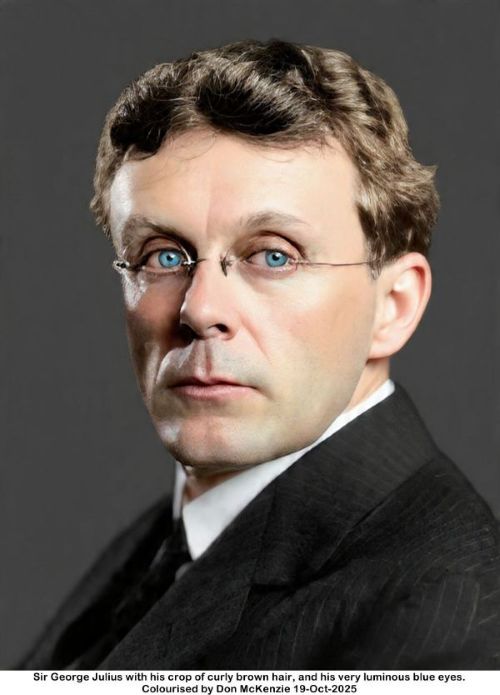
![]()
Acknowledgements

| Previous page | Go to the index | Top of the page | Next page |